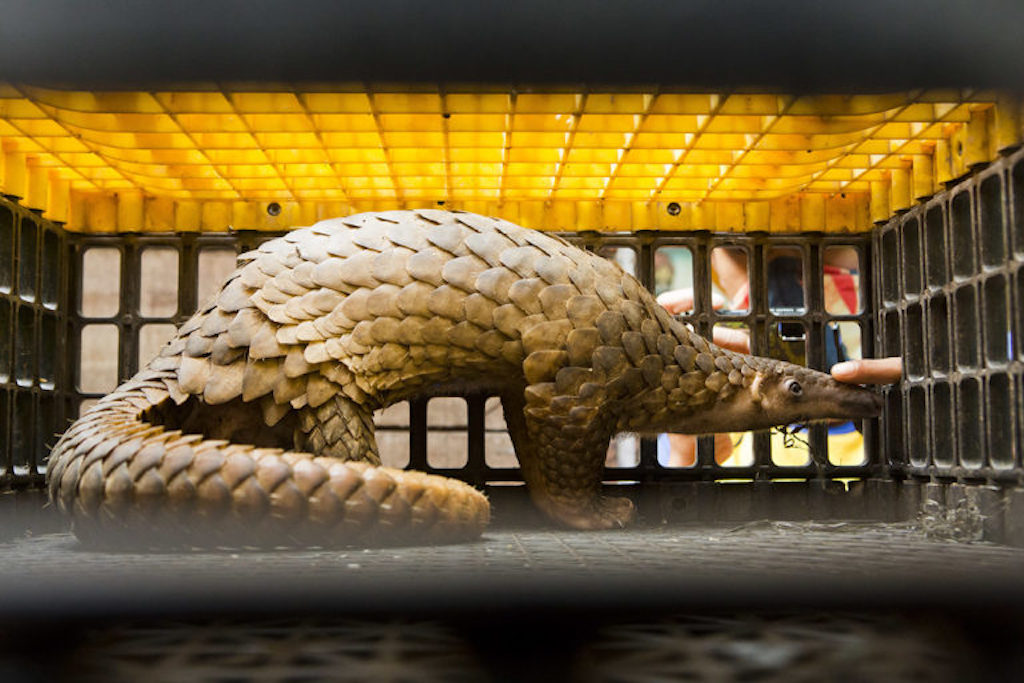
04 Jun Stockpiling wildlife in the time of lockdown
Amid the Covid-19 pandemic’s increased enforcement activities, experts noticed wildlife traffickers in Southeast Asia stockpiling animal parts in anticipation of demand recovering when restrictions are eased. Imelda Abano and Leilani Chavez report

A pangolin bust in Medan, Indonesia, in April 2015, recovered more than 4,000 frozen pangolins. Around 97 were rescued alive and 77kg of scales were confiscated. Photo: Paul Hilton for WCS
When Covid-19 emerged in early 2020 in Southeast Asia, governments in the region took rapid containment actions: lockdowns, travel restrictions and trade suspensions, alerting the public about the virus.
The pandemic has also put illegal or unsustainable wildlife trade under the spotlight due to enhanced restrictions on movement and increasing awareness about the public health risks associated with wildlife consumption. The long-term impacts, though, remain to be seen.
Recent reports on wildlife trafficking in Southeast Asia suggest that, compared to 2019, on-the-ground activity has decreased due to pandemic restrictions and weakened demand for wildlife products. However, advertisements and trade continue to proliferate on social media platforms, and there is evidence that traders may be resorting to stockpiling animal parts in anticipation of demand recovering as restrictions are eased.
Data from the fourth edition of the Counter Wildlife Trafficking Digest of the United States Agency for International Development (USAID), released on May 21 this year, indicates that seizures of pangolin parts in China, Laos, Vietnam and Thailand dropped significantly in 2020, with 48 incidents in 2020 compared to 82 in 2019. The total volume of seizures also fell sharply to 9,765kg (10.8 tons) of pangolin products from 2019’s 155,795kg (171.7 tons).
The report also found decreases in both the number and volume of seizures of tiger parts and elephant products. A total of 121 reported ivory seizures was recorded for 2020, down by 36% from 380 in 2019.
Recent data from the Philippine Department of Environment and Natural Resources (DENR) reveal a similar trend. Body parts and live specimens accounting for 58 individual animals were recovered from a total of 12 seizures in 2020. That’s the lowest number of seizures recorded by the environmental department in the past decade, down by half from 24 in 2019.
But it’s possible the pandemic did little to dissuade traffickers, despite evidence that fewer traffickers are being caught on the ground, says Serene Chng, programme officer of the wildlife trade monitoring network TRAFFIC.
“It is not clear what impact the pandemic has on wildlife trade,” Chng says. “We are still studying this, but our early assessment shows wildlife trafficking has continued despite restrictions in movements within and between countries in Southeast Asia during pandemic lockdowns.”
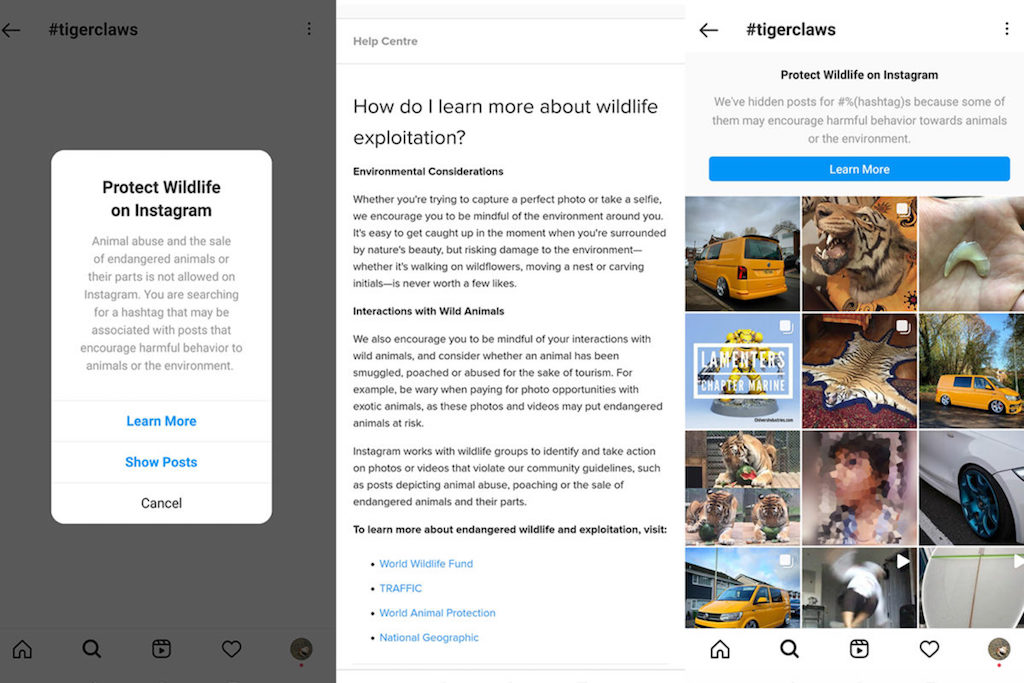
Recently, Facebook and Instagram launched pop-up messages that inform users about illegal wildlife trade when certain wildlife-related search words are entered. Image source
Wildlife crime goes digital
The trade in wildlife and wildlife products is increasingly shifting to online platforms as traffickers have found new ways to connect with potential buyers. Experts say that due to limited law enforcement capacities, encrypted online or undetected transactions, the online trade is particularly difficult to address.
Online wildlife trade persists in many countries, including in member states of the Association of Southeast Asian Nations (ASEAN), says TRAFFIC’s Chng. The lockdowns and mobility restrictions implemented due to the pandemic, which limited face-to-face transactions, bolstered these activities as the numbers of confiscated wildlife are low compared to what’s being advertised online, experts say.
“Social media is a very useful platform for reporting environmental crimes,” says Theresa Mundita Lim, executive director of the ASEAN Centre for Biodiversity. When she was director for the Biodiversity Management Bureau of the Philippines’ DENR, a post she held for 15 years, Lim says concerned individuals used social media to report environmental crimes to the DENR’s page through direct messages. These reports referred to trade both on the ground and online.
“But in the same way that authorities use it to monitor the illegal activity, traders also took advantage of social media,” Lim says. “That’s when we realised that to strengthen enforcement, we have to be a step ahead too.”
The volume of online reports and unabated on-the-ground trade propelled the environmental department to create the Philippine Operation Group in Ivory and Illegal Wildlife Trade (Task Force POGI), an inter-agency unit that was among last year’s recipients of the Asia Environmental Enforcement Award.
Recently, Facebook and Instagram launched pop-up messages informing users about the illegal wildlife trade when certain wildlife-related search words are entered. For instance, when a user searches for a protected species combined with a commercial activity such as “tiger+buy”, a pop-up will appear at the top of the search results to remind them that this activity contravenes Facebook’s policies, and directs them to more information from conservation groups such as WWF.
In some cases, searches for animal selfies on Instagram also result in an educational alert for users so they understand that, while a seemingly innocuous activity, everyone should be thoughtful about interactions with wild animals. Further, Facebook says users on both Facebook and Instagram can report live animals and wildlife products directly on the platforms for review.
Internet users in Indonesia, the Philippines and Malaysia spend an average of four hours a day online, and Facebook is the region’s top social media and commerce platform. Indonesia has the greatest number of users at 130-million, followed by the Philippines with 75-million users, Vietnam with 61-million and Thailand with 50-million users. As such, Facebook has become the prime trading ground for illegal wildlife.
Facebook’s role in the proliferation of the illicit trade has placed Indonesia — a country with very little in the way of ivory sources — at the centre of the ivory trade ring. A TRAFFIC report released last July indicated that 8,508 ivory items, from elephant tusks to jewellery and decorative items, were posted for sale on 1,559 Facebook and Instagram accounts in Indonesia, Thailand and Vietnam in 2016.
“[Indonesia] had the most traders dealing in ivory online,” the TRAFFIC report says. “These findings, coupled with recent ivory seizures from online traders in Indonesia and cross-border seizures, raise a red flag on the true extent of the country’s ivory trade.”
In 2018, social media giants Facebook, Instagram, Google, Tiktok, Pinterest and others banded together to battle the illegal wildlife trade through the Coalition to End Wildlife Trafficking Online. From the initial 21 companies, the coalition has grown to include 40 corporate partners with more than 9-billion user accounts worldwide that have reported blocking or removing more than 4-million listings that violate prohibited wildlife policies.
In 2019 Facebook and Instagram also participated in the Coalition Wildlife Cyber Spotter programme. This project trains volunteers to identify and report prohibited wildlife products and share that data with companies for time-bound actions.
Facebook’s Asia-Pacific communications team says the company doesn’t currently release data about wildlife trafficking but admits there’s more room for transparency and that it’s working on this. Facebook says it has a long-standing policy prohibiting wildlife trafficking, which it updated in 2020 to address the latest trends and threats.
TRAFFIC reported a 70% decrease in ivory items for sale on Facebook between 2016 and 2019, and a 42% decrease in groups engaging in ivory trafficking during this same period. While TRAFFIC flagged 600 posts in its study, only 557 have been removed after the study’s release, pointing to the need to strengthen Facebook’s policies against the trade.
Facebook says it partnered with wildlife monitoring networks in the coalition on ways to better equip its team of reviewers to identify violating content and to help stay up to date with the latest trends in wildlife trafficking. The training focuses on threatened animals at high risk of the trade, as well as the parts that are most highly traded, like tiger fangs and ivory, among others. In addition, training modules include images of products and common lookalikes, associated search words, and visual clues to look for.
“There is no place for illegal wildlife trade on any Facebook app, and we prohibit content and ads attempting to trade, sell or purchase endangered animals,” a Facebook spokesperson said. “Illegal wildlife trafficking is a shared challenge that goes beyond any single country, platform or company and we are always open to feedback, recommendations and new partnerships to help improve our response. In addition to proactive detection, partnerships with wildlife experts and work with law enforcement, we continue to invest to improve the enforcement of our policies.”
A series of studies on Philippine species released by Emerson Sy from TRAFFIC shows the role Facebook and online social media platforms play in the sale of critically endangered Philippine wildlife.
Sy published a study last year indicating that two-thirds of globally traded monitor lizards advertised on Facebook from 2017 to 2020 occur solely in the Philippines. Around 541 monitor lizards were found in 20 different Facebook groups during the study period; two-thirds of these monitor lizards come from 11 species that are endemic to the Philippines.
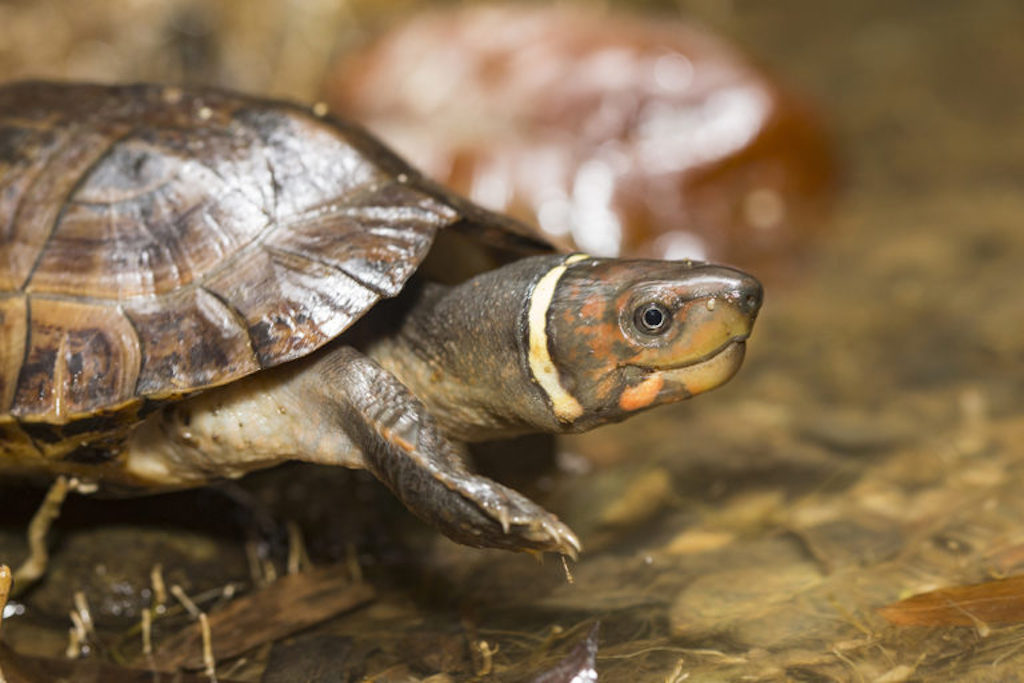
Palawan forest turtle: among the most coveted and most heavily sold in online trading sites, both in China and in the Philippines. Photo: Nicolas Cegalerba and Joanna Szwemberg for KFI
Critically endangered
Another species, the rare and critically endangered Philippine forest turtle (Siebenrockiella leytensis), is among the most coveted and most heavily sold in online trading sites, both in China and in the Philippines. Notoriously difficult to breed, it’s often passed off as captive-bred by numerous private zoos and breeding facilities, Sy says.
“There are traders who sell these turtles online and we know that they’re linked to private zoos,” he says. “These turtles are as important and as critically endangered as our Philippine eagles yet they don’t receive the same level of protection. These turtles have only been successfully bred in 2018. Any Philippine forest turtle sold before 2018 is likely poached from the wild.”
Philippine forest turtles are often monitored for sale in online trading sites in China, TRAFFIC’s report notes. Last April, the London-based wildlife monitoring group found four individuals advertising Philippine forest turtles online amid the pandemic. Two were offered for sale in a Japanese pet store, indicating the continuing demand for the species.
While Facebook strengthens its policies on wildlife trade, conservationists say that traders may have moved to other platforms like WeChat, WhatsApp, Telegram and other platforms that are hard to monitor. Regardless, experts say that the coalition is a good step forward in monitoring the online trade.
“It has become increasingly challenging for wildlife cybercriminals to post content and keep the content live on coalition platforms,” TRAFFIC’s Giavanna Grein says. “While users can always create a new account when content is removed, it takes time and trust to build connections and establish a profile or a page, which disrupts ongoing trafficking activities.”
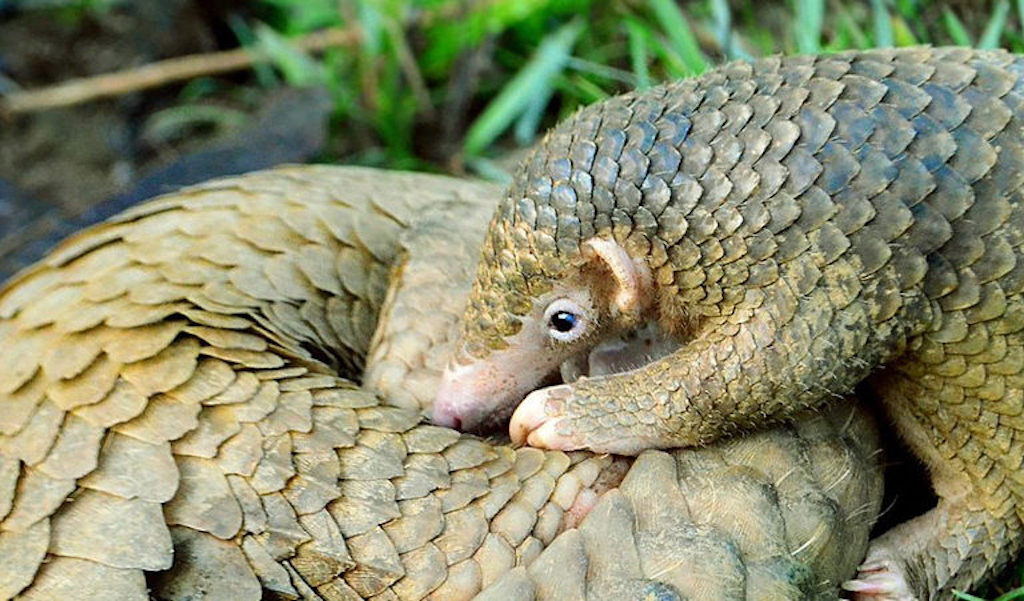
A Philippine pangolin pup and its mother, a critically endangered species. Photo: Gregg Yan (CC BY-SA 4.0)
New modus: Stockpiling
Amid the pandemic’s increased enforcement activities, experts noticed that traders employ a shift in strategies: traders resorted to stockpiling ivory, pangolin scales and fossilised giant clam shells.
In Vietnam, investigations conducted by the Environmental Investigations Agency (EIA) and the Wildlife Justice Commission (WJC) show that more than 22 tonnes of pangolin scales were being offered in Vietnam between January and March 2020, indicating that large quantities of pangolin scales are stockpiled in the country and would be ready to ship once border measures loosen. Experts also note a possible change in trade base: in Laos, traders are moving out of the capital Vientiene to unidentified bases in the countryside.
The WJC report indicated a similar strategy in the ivory trade. Increased law enforcement in Cambodia, Laos and Vietnam prompted traders to stockpile raw ivory. While China has banned domestic ivory trade since 2018, the attention has shifted to Cambodia, where there’s a “substantial open illegal ivory market driven by Chinese clientele”.
In Malaysia, a steady rise in elephant deaths in Borneo has been linked to the ivory trade and human conflict by the Sabah Wildlife Department in 2020. Last January, a pygmy elephant was gunned down, dismembered, left without a trunk and half of its skin carved out. The tusks weren’t taken, leading authorities to regard the act as retaliation over increasing enforcement activities in the area.
Since October 2020, Philippine authorities have reported seizures of more than 150 metric tons of fossilised giant clam shells based on media reports. Data from the Philippine National Police-Maritime Group, however, shows the real number is much bigger in scale: from January to April this year alone, the country’s police force confiscated around 621 metric tons of giant clam shells in nine operations across the country. Only 16 individuals were arrested, with some abandoning the loot to evade arrest.
Government data and media reports also show that the highest number of operations resulting in wildlife seizures occurred while the country was in the midst of the strictest phase of its lockdown. Figures from the Philippine National Police-Maritime Group show a total of 26 operations were conducted in 2020, leading to the arrest of 15 individuals.

Seaborne operations
The highest number of seaborne operations happened during the height of the country’s lockdown, from March 15 to April 30 2020. The biggest number of operations resulting in wildlife seizures this year also transpired while the Philippines was under another lockdown, from March 29 to May 14 2021.
The increase in coastal patrols corresponded with an increase in seizures of wildlife products. The group’s head, Oliver Tanseco, attributes this trend to the number of police checkpoints set up across the country to enforce the lockdown, freeing up maritime personnel to focus on sea-based operations.
“Aside from coastal operations, the Philippine National Police-Maritime Group also supports local peace and order,” Tanseco says. “But because numerous police personnel were deployed across the country, the Maritime Group was able to focus on coastal patrols and capture these elements.”
In Malaysia authorities seized more than 6 metric tons of African pangolin scales in April 2020 in Port Klang, the biggest seizure recorded in that port and the biggest confiscation of pangolin parts in Southeast Asia last year. This incident triggered fears among conservationists that traders may have been taking advantage of the lockdowns despite increased enforcement.
In the Philippines, the Philippine National Police-Maritime Group conducted 13 operations from January to April this year, arresting 27 individuals. In March and April, the group rescued two reticulated monitor lizards, classified as vulnerable by the IUCN; 18 birds, including the near-threatened whistling green pigeon and the endemic white-eared brown dove; and 100 pieces of lapu-lapu, a prized grouper threatened by overfishing.
The series of arrests conducted by enforcement units across the region, although lower compared to previous years, indicate that traders may be concocting new strategies to circumvent the mobility restrictions implemented by governments during the pandemic. Seizures, after all, are only the tip of the iceberg in measuring the scale of the trade, experts say.
“We make population estimates based on studies and surveys, but the number of confiscated animal parts… the number of rescued wildlife — if you include the number of wildlife that’s being sold online — all those figures exceed our population estimates,” TRAFFIC’s Sy says.
For example, estimates for the population of the Philippine forest turtles in the wild range widely from four to 121 individuals per hectare after the species was rediscovered in 2004 in Palawan province. But in 2015, a single seizure resulted in the rescue of 3,921 individuals, exceeding the population estimates, Sy says. “It shows the gaps in learning more about species behaviours and life cycles, as well as limitations in enforcement measures.”
While the pandemic brought attention to illegal wildlife trafficking, it’s unlikely to lead to its demise. “The trade may come back once the restrictions are lifted,” says Giovanni Broussard, regional coordinator of the United Nations Office on Drugs and Crime’s Global Programme for Combatting Wildlife and Forest Crime.
“When people started to feel more confident that Covid is over due to the effectivity of vaccines and their fear in consuming wildlife is not there anymore… traders are optimistic that the business will come back,” he says.
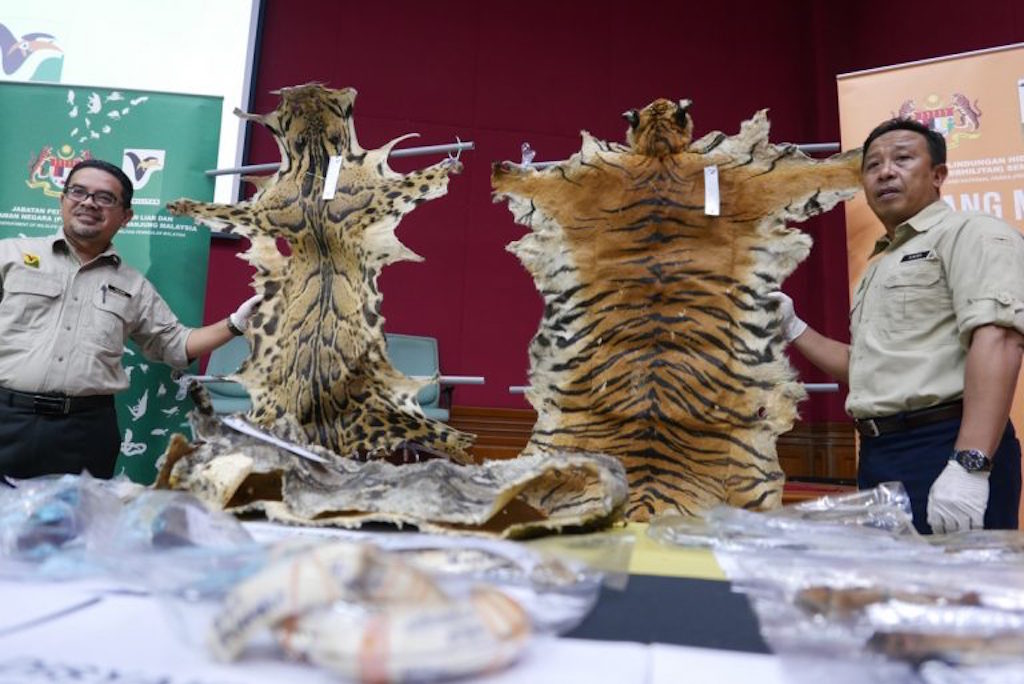
Skins of tigers and clouded leopards among wildlife parts seized by Malaysian authorities. Photo: Elizabeth John/TRAFFIC
Changing landscape
The persistence of the illegal wildlife trade, despite the slowdown wrought by Covid-19, proves that the pandemic won’t stamp out the trade, and that it “will continue unabated” in the post-Covid era, driven by market demand for food, medicine and trinkets, USAID’s report says.
Criminal networks that once sustained the ivory trade have expanded to pangolins in recent years, and the search for alternatives to ivory has seen a rapid increase in demand for giant clam shells.
The heavy trafficking of African and Asian pangolins, for one, is fuelled by its perceived benefits in traditional medicine and a curiosity for the “exotic” meat in Guangdong province, China’s biggest market for the species, a study finds.
A recent survey by WWF, released May 24, found that nearly 30% of respondents in China, Myanmar, Thailand, Vietnam and the United States say they have consumed less or stopped consuming wildlife altogether due to the pandemic. However, 9% of respondents said they were intent on purchasing wildlife products in the future.
The USAID report says Covid-19 in turn has drawn attention to the threat that the trade poses to human health, the global economy and biodiversity. But it adds the health emergency has also revealed the inadequacies of wildlife legislation, policies and enforcement on a global scale.
For example, China’s planned revisions of its wildlife laws and regulations to prevent future pandemics still have significant loopholes that permit the exploitation of threatened species for traditional medicine, a billion-dollar industry considered a key driver of species declines. The consumption ban is unlikely to impact high-level and industrial-scale wildlife trafficking, the USAID report says.
USAID’s digest also reports that a bulk of wildlife seizures occur in China and can be traced back to transshipment points in Southeast Asia, Africa and the Middle East, indicating that traders are still managing to evade border control measures amid the pandemic.
In the Philippines, officials are pushing for the revision of the country’s wildlife laws to include wildlife syndicated crime and wildlife laundering. Among the proposed amendments is an increase in jail time of up to 20 years for wildlife trafficking.
“Illegal wildlife trade is a transnational crime,” says Theresa Tenazas, head of the DENR’s Wildlife Resources Division. “The penalties in our wildlife law no longer serve as a deterrent. The landscape is changing — we live in an online era and we can’t keep up with a 20-year-old law.”
Southeast Asia’s ASEAN Comprehensive Recovery Framework, the region’s consolidated Covid-19 exit strategy, puts an emphasis on combating wildlife trafficking by sharing and exchanging information and strengthening regional enforcement mechanisms.
While leaders are aware of the need to strengthen cooperation and collaboration, Theresa Mundita Lim from the ASEAN Centre for Biodiversity says the challenge is always “operationalising” these commitments on the ground.
With changing trading strategies, several approaches are necessary, Lim says. These include awareness campaigns for consumers, the recognition of wildlife enforcers as “front-liners”, engaging with more communities as partners in combating the trade and, most importantly, providing disincentives for traders.
“There have to be disincentives for traders who engage in the illegal market trade,” Lim says. “There must be increased awareness, especially among consumers, that certain wildlife species could harbour some viruses. If it’s illegally poached, then you are sure that it didn’t undergo any health inspection and could be carriers of the next pandemic.”
The UNODC’s Broussard says strengthening the capacities of cybercrime units in some regions is key, adding that his office is assisting wildlife units and organisations in Asian countries to identify and investigate the wildlife trade by providing training in investigation and strengthening skills of law enforcers.
TRAFFIC’s Chng says a key point to address the illegal wildlife trade online is continuously to improve the public’s legal awareness. This includes triggering further investigations into particular users, enforcement actions such as seizures, and arrests by law enforcement agencies. For coalition partners like the social media giants, she says this includes continuing to close or suspend groups and accounts that violate policies.
This article was supported by Internews’ Earth Journalism Network and appeared in Mongabay here
Use the #WildEye Asia tool to track wildlife crimes and court cases
